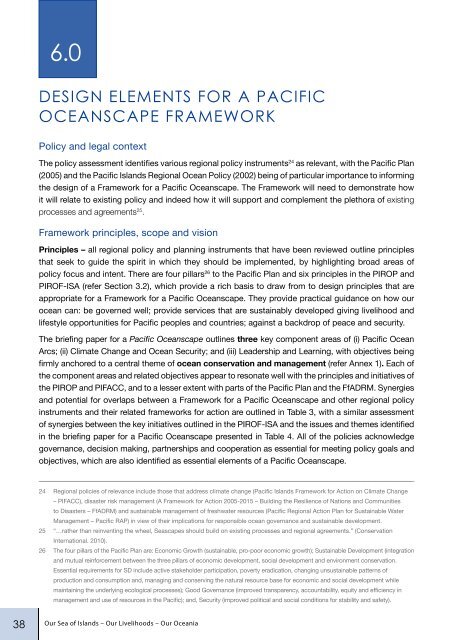Our Sea of Islands Our Livelihoods Our Oceania - SPREP
Our Sea of Islands Our Livelihoods Our Oceania - SPREP
Our Sea of Islands Our Livelihoods Our Oceania - SPREP
Create successful ePaper yourself
Turn your PDF publications into a flip-book with our unique Google optimized e-Paper software.
6.0<br />
desIgn eleMenTs fOR a PaCIfIC<br />
OCeansCaPe fRaMewORk<br />
Policy and legal context<br />
The policy assessment identifies various regional policy instruments 24 as relevant, with the Pacific Plan<br />
(2005) and the Pacific <strong>Islands</strong> Regional Ocean Policy (2002) being <strong>of</strong> particular importance to informing<br />
the design <strong>of</strong> a Framework for a Pacific Oceanscape. The Framework will need to demonstrate how<br />
it will relate to existing policy and indeed how it will support and complement the plethora <strong>of</strong> existing<br />
processes and agreements 25 .<br />
Framework principles, scope and vision<br />
Principles – all regional policy and planning instruments that have been reviewed outline principles<br />
that seek to guide the spirit in which they should be implemented, by highlighting broad areas <strong>of</strong><br />
policy focus and intent. There are four pillars26 to the Pacific Plan and six principles in the PIROP and<br />
PIROF-ISA (refer Section 3.2), which provide a rich basis to draw from to design principles that are<br />
appropriate for a Framework for a Pacific Oceanscape. They provide practical guidance on how our<br />
ocean can: be governed well; provide services that are sustainably developed giving livelihood and<br />
lifestyle opportunities for Pacific peoples and countries; against a backdrop <strong>of</strong> peace and security.<br />
The briefing paper for a Pacific Oceanscape outlines three key component areas <strong>of</strong> (i) Pacific Ocean<br />
Arcs; (ii) Climate Change and Ocean Security; and (iii) Leadership and Learning, with objectives being<br />
firmly anchored to a central theme <strong>of</strong> ocean conservation and management (refer Annex 1). Each <strong>of</strong><br />
the component areas and related objectives appear to resonate well with the principles and initiatives <strong>of</strong><br />
the PIROP and PIFACC, and to a lesser extent with parts <strong>of</strong> the Pacific Plan and the FfADRM. Synergies<br />
and potential for overlaps between a Framework for a Pacific Oceanscape and other regional policy<br />
instruments and their related frameworks for action are outlined in Table 3, with a similar assessment<br />
<strong>of</strong> synergies between the key initiatives outlined in the PIROF-ISA and the issues and themes identified<br />
in the briefing paper for a Pacific Oceanscape presented in Table 4. All <strong>of</strong> the policies acknowledge<br />
governance, decision making, partnerships and cooperation as essential for meeting policy goals and<br />
objectives, which are also identified as essential elements <strong>of</strong> a Pacific Oceanscape.<br />
24 Regional policies <strong>of</strong> relevance include those that address climate change (Pacific <strong>Islands</strong> Framework for Action on Climate Change<br />
– PIFACC), disaster risk management (A Framework for Action 2005-2015 – Building the Resilience <strong>of</strong> Nations and Communities<br />
to Disasters – FfADRM) and sustainable management <strong>of</strong> freshwater resources (Pacific Regional Action Plan for Sustainable Water<br />
Management – Pacific RAP) in view <strong>of</strong> their implications for responsible ocean governance and sustainable development.<br />
25 “…rather than reinventing the wheel, <strong>Sea</strong>scapes should build on existing processes and regional agreements.” (Conservation<br />
International. 2010).<br />
26 The four pillars <strong>of</strong> the Pacific Plan are: Economic Growth (sustainable, pro-poor economic growth); Sustainable Development (integration<br />
and mutual reinforcement between the three pillars <strong>of</strong> economic development, social development and environment conservation.<br />
Essential requirements for SD include active stakeholder participation, poverty eradication, changing unsustainable patterns <strong>of</strong><br />
production and consumption and, managing and conserving the natural resource base for economic and social development while<br />
maintaining the underlying ecological processes); Good Governance (improved transparency, accountability, equity and efficiency in<br />
management and use <strong>of</strong> resources in the Pacific); and, Security (improved political and social conditions for stability and safety).<br />
38 <strong>Our</strong> <strong>Sea</strong> <strong>of</strong> <strong>Islands</strong> – <strong>Our</strong> <strong>Livelihoods</strong> – <strong>Our</strong> <strong>Oceania</strong>
















